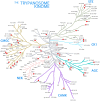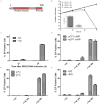Regulators of Trypanosoma brucei cell cycle progression and differentiation identified using a kinome-wide RNAi screen
- PMID: 24453978
- PMCID: PMC3894213
- DOI: 10.1371/journal.ppat.1003886
Regulators of Trypanosoma brucei cell cycle progression and differentiation identified using a kinome-wide RNAi screen
Abstract
The African trypanosome, Trypanosoma brucei, maintains an integral link between cell cycle regulation and differentiation during its intricate life cycle. Whilst extensive changes in phosphorylation have been documented between the mammalian bloodstream form and the insect procyclic form, relatively little is known about the parasite's protein kinases (PKs) involved in the control of cellular proliferation and differentiation. To address this, a T. brucei kinome-wide RNAi cell line library was generated, allowing independent inducible knockdown of each of the parasite's 190 predicted protein kinases. Screening of this library using a cell viability assay identified ≥42 PKs that are required for normal bloodstream form proliferation in culture. A secondary screen identified 24 PKs whose RNAi-mediated depletion resulted in a variety of cell cycle defects including in G1/S, kinetoplast replication/segregation, mitosis and cytokinesis, 15 of which are novel cell cycle regulators. A further screen identified for the first time two PKs, named repressor of differentiation kinase (RDK1 and RDK2), depletion of which promoted bloodstream to procyclic form differentiation. RDK1 is a membrane-associated STE11-like PK, whilst RDK2 is a NEK PK that is essential for parasite proliferation. RDK1 acts in conjunction with the PTP1/PIP39 phosphatase cascade to block uncontrolled bloodstream to procyclic form differentiation, whilst RDK2 is a PK whose depletion efficiently induces differentiation in the absence of known triggers. Thus, the RNAi kinome library provides a valuable asset for functional analysis of cell signalling pathways in African trypanosomes as well as drug target identification and validation.
Conflict of interest statement
The authors have declared that no competing interests exist.
Figures


 ) when their parasitaemias rose above 108 cells ml−1.
) when their parasitaemias rose above 108 cells ml−1.



Similar articles
-
Functional Analyses of Cytokinesis Regulators in Bloodstream Stage Trypanosoma brucei Parasites Identify Functions and Regulations Specific to the Life Cycle Stage.mSphere. 2019 May 1;4(3):e00199-19. doi: 10.1128/mSphere.00199-19. mSphere. 2019. PMID: 31043517 Free PMC article.
-
RNAi screening identifies Trypanosoma brucei stress response protein kinases required for survival in the mouse.Sci Rep. 2017 Jul 21;7(1):6156. doi: 10.1038/s41598-017-06501-8. Sci Rep. 2017. PMID: 28733613 Free PMC article.
-
Trypanosoma brucei Tim50 Possesses PAP Activity and Plays a Critical Role in Cell Cycle Regulation and Parasite Infectivity.mBio. 2021 Oct 26;12(5):e0159221. doi: 10.1128/mBio.01592-21. Epub 2021 Sep 14. mBio. 2021. PMID: 34517757 Free PMC article.
-
Regulation of the cell division cycle in Trypanosoma brucei.Eukaryot Cell. 2012 Oct;11(10):1180-90. doi: 10.1128/EC.00145-12. Epub 2012 Aug 3. Eukaryot Cell. 2012. PMID: 22865501 Free PMC article. Review.
-
Assembling the components of the quorum sensing pathway in African trypanosomes.Mol Microbiol. 2015 Apr;96(2):220-32. doi: 10.1111/mmi.12949. Epub 2015 Mar 4. Mol Microbiol. 2015. PMID: 25630552 Free PMC article. Review.
Cited by
-
Simplified inducible system for Trypanosoma brucei.PLoS One. 2018 Oct 11;13(10):e0205527. doi: 10.1371/journal.pone.0205527. eCollection 2018. PLoS One. 2018. PMID: 30308039 Free PMC article.
-
Non-linear hierarchy of the quorum sensing signalling pathway in bloodstream form African trypanosomes.PLoS Pathog. 2018 Jun 25;14(6):e1007145. doi: 10.1371/journal.ppat.1007145. eCollection 2018 Jun. PLoS Pathog. 2018. PMID: 29940034 Free PMC article.
-
The design and synthesis of potent and selective inhibitors of Trypanosoma brucei glycogen synthase kinase 3 for the treatment of human african trypanosomiasis.J Med Chem. 2014 Sep 25;57(18):7536-49. doi: 10.1021/jm500239b. Epub 2014 Sep 8. J Med Chem. 2014. PMID: 25198388 Free PMC article.
-
Two cold shock domain containing proteins trigger the development of infectious Trypanosoma brucei.PLoS Pathog. 2023 Jun 5;19(6):e1011438. doi: 10.1371/journal.ppat.1011438. eCollection 2023 Jun. PLoS Pathog. 2023. PMID: 37276216 Free PMC article.
-
An essential signal peptide peptidase identified in an RNAi screen of serine peptidases of Trypanosoma brucei.PLoS One. 2015 Mar 27;10(3):e0123241. doi: 10.1371/journal.pone.0123241. eCollection 2015. PLoS One. 2015. PMID: 25816352 Free PMC article.
References
-
- Vassella E, Reuner B, Yutzy B, Boshart M (1997) Differentiation of African trypanosomes is controlled by a density sensing mechanism which signals cell cycle arrest via the cAMP pathway. J Cell Sci 110: 2661–2671. - PubMed
-
- Vassella E, Krämer R, Turner CMR, Wankell M, Modes C, Van den Bogaard M, Boshart M (2001) Deletion of a novel protein kinase with PX and FYVE-related domains increases the rate of differentiation of Trypanosoma brucei . Mol Microbiol 41: 33–46. - PubMed
Publication types
MeSH terms
Substances
Grants and funding
LinkOut - more resources
Full Text Sources
Other Literature Sources
Molecular Biology Databases
Research Materials
Miscellaneous

